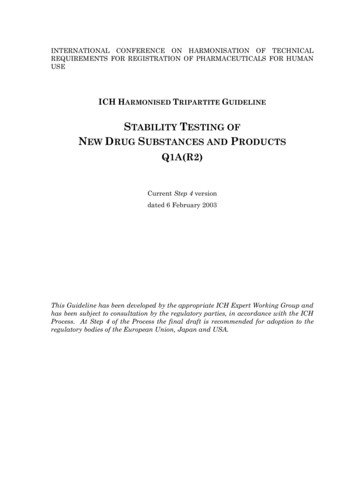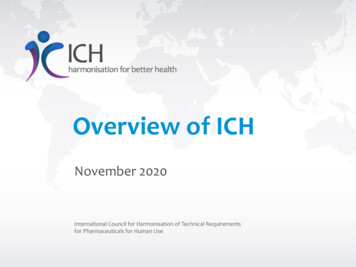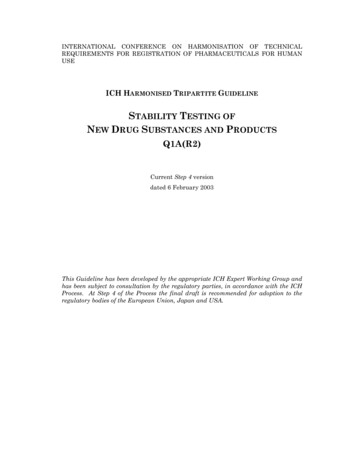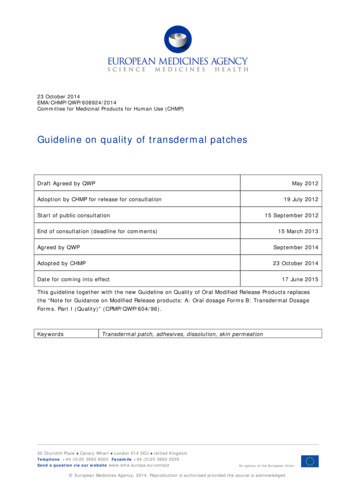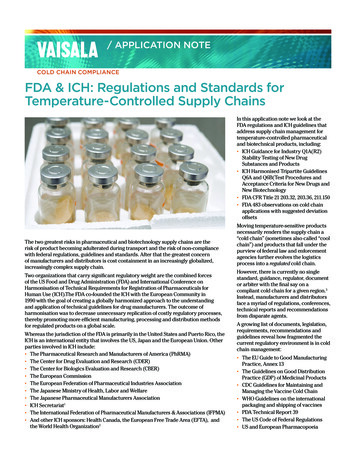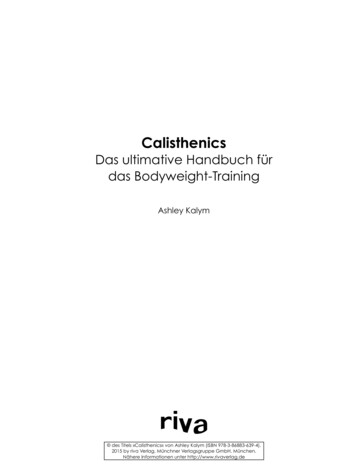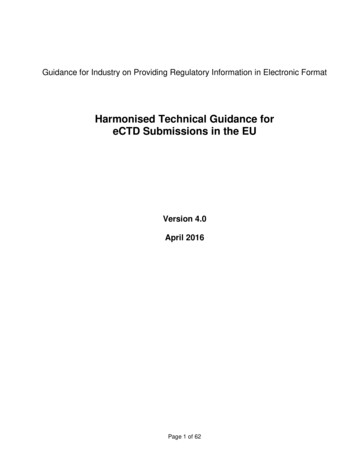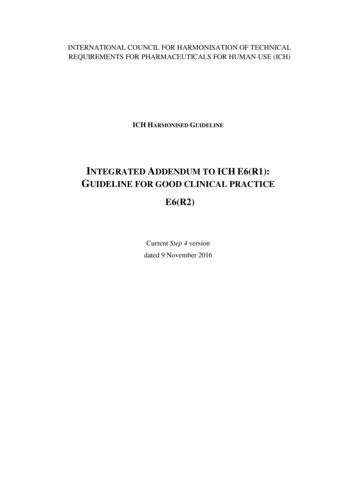
Transcription
INTERNATIONAL COUNCIL FOR HARMONISATION OF TECHNICALREQUIREMENTS FOR PHARMACEUTICALS FOR HUMAN USE (ICH)ICH HARMONISED GUIDELINEINTEGRATED ADDENDUM TO ICH E6(R1):GUIDELINE FOR GOOD CLINICAL PRACTICEE6(R2)Current Step 4 versiondated 9 November 2016
E6(R1)Document 5HistoryDateE6Approval by the Steering Committee under Step 2and release for public consultation.27April1995E6E6Approval by the Steering Committee under Step 4and recommended for adoption to the three ICHregulatory bodies.1May1996E610June1996E6(R1)E6(R1) Step 4 versionE6CodeE6(R2)Approval by the Steering Committee of Post-Step 4editorial corrections.Current E6(R2) Addendum Step 4 versionHistoryAdoption by the Regulatory Members of the ICH Assemblyunder Step 4.Date9 November2016Integrated Addendum to ICH E6(R1) document. Changes areintegrated directly into the following sections of the parentalGuideline: Introduction, 1.63, 1.64, 1.65, 2.10, 2.13, 4.2.5, 4.2.6,4.9.0, 5.0, 5.0.1, 5.0.2, 5.0.3, 5.0.4, 5.0.5, 5.0.6, 5.0.7, 5.2.2,5.5.3 (a), 5.5.3 (b), 5.5.3 (h), 5.18.3, 5.18.6 (e), 5.18.7, 5.20.1,8.1Legal notice: This document is protected by copyright and may be used, reproduced, incorporatedinto other works, adapted, modified, translated or distributed under a public license provided thatICH's copyright in the document is acknowledged at all times. In case of any adaption, modificationor translation of the document, reasonable steps must be taken to clearly label, demarcate orotherwise identify that changes were made to or based on the original document. Any impression thatthe adaption, modification or translation of the original document is endorsed or sponsored by theICH must be avoided.The document is provided "as is" without warranty of any kind. In no event shall the ICH or theauthors of the original document be liable for any claim, damages or other liability arising from theuse of the document.The above-mentioned permissions do not apply to content supplied by third parties. Therefore, fordocuments where the copyright vests in a third party, permission for reproduction must be obtainedfrom this copyright holder.
ICH HARMONISED GUIDELINEINTEGRATED ADDENDUM TO ICH E6(R1): GUIDELINE FORGOOD CLINICAL PRACTICE ICHE6(R2)ICH Consensus GuidelineTABLE OF CONTENTSINTRODUCTION. 11.GLOSSARY . 22.THE PRINCIPLES OF ICH GCP . 93.INSTITUTIONAL REVIEW BOARD/INDEPENDENT ETHICS COMMITTEE(IRB/IEC) . 103.1Responsibilities . 103.2Composition, Functions and Operations . 113.3Procedures. 113.4Records . 124.INVESTIGATOR . 134.1Investigator's Qualifications and Agreements . 134.2Adequate Resources . 134.3Medical Care of Trial Subjects . 144.4Communication with IRB/IEC . 144.5Compliance with Protocol . 144.6Investigational Product(s) . 154.7Randomization Procedures and Unblinding . 154.8Informed Consent of Trial Subjects . 164.9Records and Reports . 194.10 Progress Reports . 194.11 Safety Reporting . 204.12 Premature Termination or Suspension of a Trial . 204.13 Final Report(s) by Investigator . 205.SPONSOR . 215.0Quality Management . 215.1Quality Assurance and Quality Control . 225.2Contract Research Organization (CRO). 225.3Medical Expertise. 23i
Integrated Addendum to E6(R1): Guideline for Good Clinical Practice5.4Trial Design. 235.5Trial Management, Data Handling, and Record Keeping . 235.6Investigator Selection . 255.7Allocation of Responsibilities . 255.8Compensation to Subjects and Investigators . 255.9Financing . 265.10 Notification/Submission to Regulatory Authority(ies) . 265.11 Confirmation of Review by IRB/IEC . 265.12 Information on Investigational Product(s) . 265.13 Manufacturing, Packaging, Labelling, and Coding Investigational Product(s) . 275.14 Supplying and Handling Investigational Product(s) . 275.15 Record Access . 285.16 Safety Information. 285.17 Adverse Drug Reaction Reporting . 285.18 Monitoring . 295.18.1Purpose . 295.18.2Selection and Qualifications of Monitors . 295.18.3Extent and Nature of Monitoring . 295.18.5Monitoring Procedures. 315.18.6Monitoring Report. 325.18.7Monitoring Plan . 325.19 Audit . 325.19.1Purpose . 325.19.2Selection and Qualification of Auditors . 325.19.3Auditing Procedures . 335.20 Noncompliance . 335.21 Premature Termination or Suspension of a Trial . 335.22 Clinical Trial/Study Reports . 335.23 Multicentre Trials . 346.CLINICAL TRIAL PROTOCOL AND PROTOCOL AMENDMENT(S) . 346.1General Information . 346.2Background Information . 356.3Trial Objectives and Purpose . 356.4Trial Design. 356.5Selection and Withdrawal of Subjects . 366.6Treatment of Subjects . 366.7Assessment of Efficacy . 36ii
Integrated Addendum to E6(R1): Guideline for Good Clinical Practice6.8Assessment of Safety . 366.9Statistics. 376.10 Direct Access to Source Data/Documents . 376.11 Quality Control and Quality Assurance . 376.12 Ethics . 376.13 Data Handling and Record Keeping . 376.14 Financing and Insurance. 376.15 Publication Policy . 376.16 Supplements . 377.INVESTIGATOR’S BROCHURE. 387.1Introduction . 387.2General Considerations . 387.37.2.1Title Page . 387.2.2Confidentiality Statement . 39Contents of the Investigator’s Brochure . 397.3.1Table of Contents . 397.3.2Summary . 397.3.3Introduction . 397.3.4Physical, Chemical, and Pharmaceutical Properties and Formulation . 397.3.5Nonclinical Studies . 397.3.6Effects in Humans . 417.3.7Summary of Data and Guidance for the Investigator . 427.4APPENDIX 1: . 437.5APPENDIX 2: . 448.ESSENTIAL DOCUMENTS FOR THE CONDUCT OF A CLINICAL TRIAL . 458.1Introduction . 458.2Before the Clinical Phase of the Trial Commences . 468.3During the Clinical Conduct of the Trial . 538.4After Completion or Termination of the Trial . 59iii
INTEGRATED ADDENDUM TO ICH E6(R1): GUIDELINE FORGOOD CLINICAL PRACTICE ICHE6(R2)INTRODUCTIONGood Clinical Practice (GCP) is an international ethical and scientific quality standard fordesigning, conducting, recording and reporting trials that involve the participation of humansubjects. Compliance with this standard provides public assurance that the rights, safety andwell-being of trial subjects are protected, consistent with the principles that have their originin the Declaration of Helsinki, and that the clinical trial data are credible.The objective of this ICH GCP Guideline is to provide a unified standard for the EuropeanUnion (EU), Japan and the United States to facilitate the mutual acceptance of clinical databy the regulatory authorities in these jurisdictions.The guideline was developed with consideration of the current good clinical practices of theEuropean Union, Japan, and the United States, as well as those of Australia, Canada, theNordic countries and the World Health Organization (WHO).This guideline should be followed when generating clinical trial data that are intended to besubmitted to regulatory authorities.The principles established in this guideline may also be applied to other clinicalinvestigations that may have an impact on the safety and well-being of human subjects.ADDENDUMSince the development of the ICH GCP Guideline, the scale, complexity, and cost of clinicaltrials have increased. Evolutions in technology and risk management processes offer newopportunities to increase efficiency and focus on relevant activities. When the original ICHE6(R1) text was prepared, clinical trials were performed in a largely paper-based process.Advances in use of electronic data recording and reporting facilitate implementation of otherapproaches. For example, centralized monitoring can now offer a greater advantage, to abroader range of trials than is suggested in the original text. Therefore, this guideline hasbeen amended to encourage implementation of improved and more efficient approaches toclinical trial design, conduct, oversight, recording and reporting while continuing to ensurehuman subject protection and reliability of trial results. Standards regarding electronicrecords and essential documents intended to increase clinical trial quality and efficiency havealso been updated.This guideline should be read in conjunction with other ICH guidelines relevant to theconduct of clinical trials (e.g., E2A (clinical safety data management), E3 (clinical studyreporting), E7 (geriatric populations), E8 (general considerations for clinical trials), E9(statistical principles), and E11 (pediatric populations)).This ICH GCP Guideline Integrated Addendum provides a unified standard for the EuropeanUnion, Japan, the United States, Canada, and Switzerland to facilitate the mutual acceptanceof data from clinical trials by the regulatory authorities in these jurisdictions. In the event ofany conflict between the E6(R1) text and the E6(R2) addendum text, the E6(R2) addendumtext should take priority.1
1.GLOSSARY1.1Adverse Drug Reaction (ADR)In the pre-approval clinical experience with a new medicinal product or its new usages,particularly as the therapeutic dose(s) may not be established: all noxious and unintendedresponses to a medicinal product related to any dose should be considered adverse drugreactions. The phrase responses to a medicinal product means that a causal relationship betweena medicinal product and an adverse event is at least a reasonable possibility, i.e., the relationshipcannot be ruled out.Regarding marketed medicinal products: a response to a drug which is noxious and unintendedand which occurs at doses normally used in man for prophylaxis, diagnosis, or therapy ofdiseases or for modification of physiological function (see the ICH Guideline for Clinical SafetyData Management: Definitions and Standards for Expedited Reporting).1.2Adverse Event (AE)Any untoward medical occurrence in a patient or clinical investigation subject administered apharmaceutical product and which does not necessarily have a causal relationship with thistreatment. An adverse event (AE) can therefore be any unfavourable and unintended sign(including an abnormal laboratory finding), symptom, or disease temporally associated with theuse of a medicinal (investigational) product, whether or not related to the medicinal(investigational) product (see the ICH Guideline for Clinical Safety Data Management:Definitions and Standards for Expedited Reporting).1.3Amendment (to the protocol)See Protocol Amendment.1.4Applicable Regulatory Requirement(s)Any law(s) and regulation(s) addressing the conduct of clinical trials of investigational products.1.5Approval (in relation to Institutional Review Boards)The affirmative decision of the IRB that the clinical trial has been reviewed and may beconducted at the institution site within the constraints set forth by the IRB, the institution, GoodClinical Practice (GCP), and the applicable regulatory requirements.1.6AuditA systematic and independent examination of trial related activities and documents to determinewhether the evaluated trial related activities were conducted, and the data were recorded,analyzed and accurately reported according to the protocol, sponsor's standard operatingprocedures (SOPs), Good Clinical Practice (GCP), and the applicable regulatory requirement(s).1.7Audit CertificateA declaration of confirmation by the auditor that an audit has taken place.1.8Audit ReportA written evaluation by the sponsor's auditor of the results of the audit.2
Integrated Addendum to ICH E6(R1): Guideline for Good Clinical Practice1.9Audit TrailDocumentation that allows reconstruction of the course of events.1.10 Blinding/MaskingA procedure in which one or more parties to the trial are kept unaware of the treatmentassignment(s). Single-blinding usually refers to the subject(s) being unaware, and doubleblinding usually refers to the subject(s), investigator(s), monitor, and, in some cases, dataanalyst(s) being unaware of the treatment assignment(s).1.11 Case Report Form (CRF)A printed, optical, or electronic document designed to record all of the protocol requiredinformation to be reported to the sponsor on each trial subject.1.12 Clinical Trial/StudyAny investigation in human subjects intended to discover or verify the clinical, pharmacologicaland/or other pharmacodynamic effects of an investigational product(s), and/or to identify anyadverse reactions to an investigational product(s), and/or to study absorption, distribution,metabolism, and excretion of an investigational product(s) with the object of ascertaining itssafety and/or efficacy. The terms clinical trial and clinical study are synonymous.1.13 Clinical Trial/Study ReportA written description of a trial/study of any therapeutic, prophylactic, or diagnostic agentconducted in human subjects, in which the clinical and statistical description, presentations, andanalyses are fully integrated into a single report (see the ICH Guideline for Structure and Contentof Clinical Study Reports).1.14 Comparator (Product)An investigational or marketed product (i.e., active control), or placebo, used as a reference in aclinical trial.1.15 Compliance (in relation to trials)Adherence to all the trial-related requirements, Good Clinical Practice (GCP) requirements, andthe applicable regulatory requirements.1.16 ConfidentialityPrevention of disclosure, to other than authorized individuals, of a sponsor's proprietaryinformation or of a subject's identity.1.17 ContractA written, dated, and signed agreement between two or more involved parties that sets out anyarrangements on delegation and distribution of tasks and obligations and, if appropriate, onfinancial matters. The protocol may serve as the basis of a contract.1.18 Coordinating CommitteeA committee that a sponsor may organize to coordinate the conduct of a multicentre trial.1.19 Coordinating InvestigatorAn investigator assigned the responsibility for the coordination of investigators at differentcentres participating in a multicentre trial.3
Integrated Addendum to ICH E6(R1): Guideline for Good Clinical Practice1.20 Contract Research Organization (CRO)A person or an organization (commercial, academic, or other) contracted by the sponsor toperform one or more of a sponsor's trial-related duties and functions.1.21 Direct AccessPermission to examine, analyze, verify, and reproduce any records and reports that are importantto evaluation of a clinical trial. Any party (e.g., domestic and foreign regulatory authorities,sponsor's monitors and auditors) with direct access should take all reasonable precautions withinthe constraints of the applicable regulatory requirement(s) to maintain the confidentiality ofsubjects' identities and sponsor’s proprietary information.1.22 DocumentationAll records, in any form (including, but not limited to, written, electronic, magnetic, and opticalrecords, and scans, x-rays, and electrocardiograms) that describe or record the methods, conduct,and/or results of a trial, the factors affecting a trial, and the actions taken.1.23 Essential DocumentsDocuments which individually and collectively permit evaluation of the conduct of a study andthe quality of the data produced (see 8. Essential Documents for the Conduct of a Clinical Trial).1.24 Good Clinical Practice (GCP)A standard for the design, conduct, performance, monitoring, auditing, recording, analyses, andreporting of clinical trials that provides assurance that the data and reported results are credibleand accurate, and that the rights, integrity, and confidentiality of trial subjects are protected.1.25 Independent Data-Monitoring Committee (IDMC) (Data and Safety MonitoringBoard, Monitoring Committee, Data Monitoring Committee)An independent data-monitoring committee that may be established by the sponsor to assess atintervals the progress of a clinical trial, the safety data, and the critical efficacy endpoints, and torecommend to the sponsor whether to continue, modify, or stop a trial.1.26 Impartial WitnessA person, who is independent of the trial, who cannot be unfairly influenced by people involvedwith the trial, who attends the informed consent process if the subject or the subject’s legallyacceptable representative cannot read, and who reads the informed consent form and any otherwritten information supplied to the subject.1.27 Independent Ethics Committee (IEC)An independent body (a review board or a committee, institutional, regional, national, orsupranational), constituted of medical professionals and non-medical members, whoseresponsibility it is to ensure the protection of the rights, safety and well-being of human subjectsinvolved in a trial and to provide public assurance of that protection, by, among other things,reviewing and approving/providing favourable opinion on, the trial protocol, the suitability of theinvestigator(s), facilities, and the methods and material to be used in obtaining and documentinginformed consent of the trial subjects.The legal status, composition, function, operations and regulatory requirements pertaining toIndependent Ethics Committees may differ among countries, but should allow the IndependentEthics Committee to act in agreement with GCP as described in this guideline.4
Integrated Addendum to ICH E6(R1): Guideline for Good Clinical Practice1.28 Informed ConsentA process by which a subject voluntarily confirms his or her willingness to participate in aparticular trial, after having been informed of all aspects of the trial that are relevant to thesubject's decision to participate. Informed consent is documented by means of a written, signedand dated informed consent form.1.29 InspectionThe act by a regulatory authority(ies) of conducting an official review of documents, facilities,records, and any other resources that are deemed by the authority(ies) to be related to the clinicaltrial and that may be located at the site of the trial, at the sponsor's and/or contract researchorganization’s (CRO’s) facilities, or at other establishments deemed appropriate by theregulatory authority(ies).1.30 Institution (medical)Any public or private entity or agency or medical or dental facility where clinical trials areconducted.1.31 Institutional Review Board (IRB)An independent body constituted of medical, scientific, and non-scientific members, whoseresponsibility is to ensure the protection of the rights, safety and well-being of human subjectsinvolved in a trial by, among other things, reviewing, approving, and providing continuingreview of trial protocol and amendments and of the methods and material to be used in obtainingand documenting informed consent of the trial subjects.1.32 Interim Clinical Trial/Study ReportA report of intermediate results and their evaluation based on analyses performed during thecourse of a trial.1.33 Investigational ProductA pharmaceutical form of an active ingredient or placebo being tested or used as a reference in aclinical trial, including a product with a marketing authorization when used or assembled(formulated or packaged) in a way different from the approved form, or when used for anunapproved indication, or when used to gain further information about an approved use.1.34 InvestigatorA person responsible for the conduct of the clinical trial at a trial site. If a trial is conducted by ateam of individuals at a trial site, the investigator is the responsible leader of the team and maybe called the principal investigator. See also Subinvestigator.1.35 Investigator/InstitutionAn expression meaning "the investigator and/or institution, where required by the applicableregulatory requirements".1.36 Investigator's BrochureA compilation of the clinical and nonclinical data on the investigational product(s) which isrelevant to the study of the investigational product(s) in human subjects (see 7. Investigator’sBrochure).1.37 Legally Acceptable RepresentativeAn individual or juridical or other body authorized under applicable law to consent, on behalf ofa prospective subject, to the subject's participation in the clinical trial.5
Integrated Addendum to ICH E6(R1): Guideline for Good Clinical Practice1.38 MonitoringThe act of overseeing the progress of a clinical trial, and of ensuring that it is conducted,recorded, and reported in accordance with the protocol, Standard Operating Procedures (SOPs),Good Clinical Practice (GCP), and the applicable regulatory requirement(s).1.39Monitoring ReportA written report from the monitor to the sponsor after each site visit and/or other trial-relatedcommunication according to the sponsor’s SOPs.1.40Multicentre TrialA clinical trial conducted according to a single protocol but at more than one site, and therefore,carried out by more than one investigator.1.41 Nonclinical StudyBiomedical studies not performed on human subjects.1.42 Opinion (in relation to Independent Ethics Committee)The judgement and/or the advice provided by an Independent Ethics Committee (IEC).1.43 Original Medical RecordSee Source Documents.1.44 ProtocolA document that describes the objective(s), design, methodology, statistical considerations, andorganization of a trial. The protocol usually also gives the background and rationale for the trial,but these could be provided in other protocol referenced documents. Throughout the ICH GCPGuideline the term protocol refers to protocol and protocol amendments.1.45 Protocol AmendmentA written description of a change(s) to or formal clarification of a protocol.1.46 Quality Assurance (QA)All those planned and systematic actions that are established to ensure that the trial is performedand the data are generated, documented (recorded), and reported in compliance with GoodClinical Practice (GCP) and the applicable regulatory requirement(s).1.47 Quality Control (QC)The operational techniques and activities undertaken within the quality assurance system toverify that the requirements for quality of the trial-related activities have been fulfilled.1.48 RandomizationThe process of assigning trial subjects to treatment or control groups using an element of chanceto determine the assignments in order to reduce bias.1.49 Regulatory AuthoritiesBodies having the power to regulate. In the ICH GCP Guideline the expression RegulatoryAuthorities includes the authorities that review submitted clinical data and those that conductinspections (
New Codification November 2005 E6 Approval by the Steering Committee under Step 2 and release for public consultation. 27 April 1995 E6 E6 Approval by the Steering Committee under Step 4 and recommended for adoption to the three ICH regulatory bodies. 1 May 1996 E6 E6(R1) Step 4 version E6 Approval by the Steering Committee of Post-Step 4

